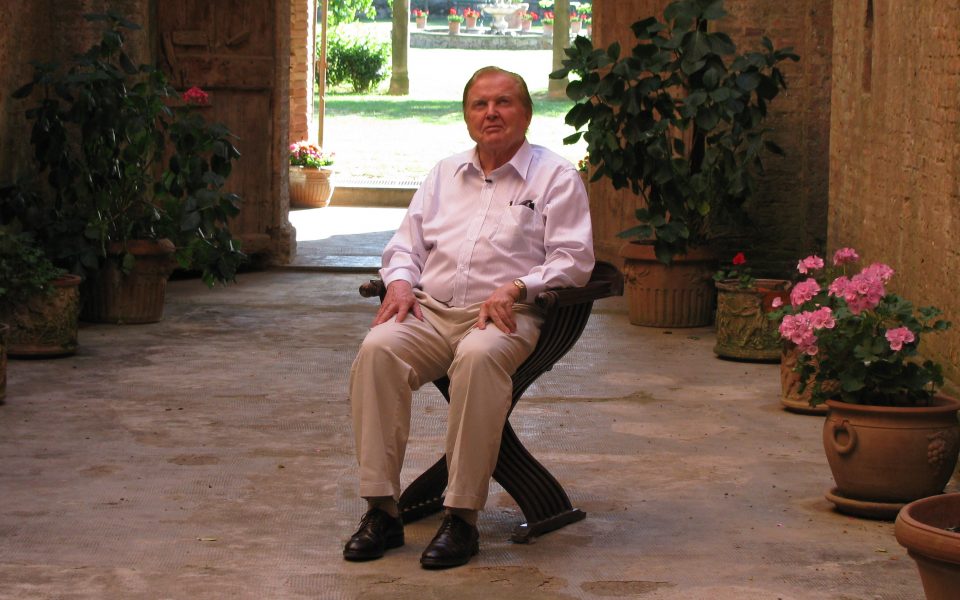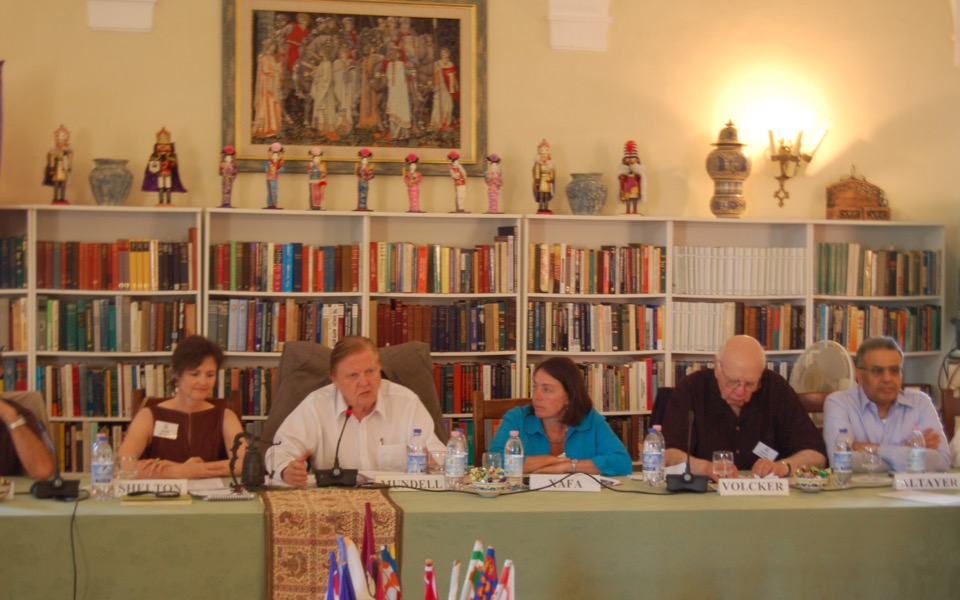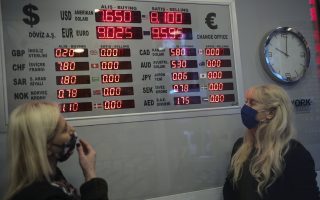Robert Mundell, 1932-2021: Ahead of his time

I met Bob Mundell in Washington in 1982, when I was already working at the International Monetary Fund, at a conference on the international monetary system. My first impression was the absolute confidence with which he expressed his views. When one of the participants in his panel claimed that the data did not confirm his views, he responded: “If the data do not confirm my views, then the data is wrong.” I had the chance to follow his life and career, and to participate in the conferences he organized in the last two decades in his beloved Palazzo Mundell in Tuscany where he lived.
Mundell pioneered the theory that serves as the basis for the design and implementation of economic policies in open economies. It is hard to appreciate today his path-breaking thinking on economic issues that had yet to emerge, at a time when the world was dominated by fixed exchange rates and capital controls. In awarding him the 1999 Nobel prize in economics, the Swedish Academy of Sciences notes that: “His contribution to monetary theory and optimum currency areas remains outstanding and has inspired generations of researchers. Mundell chose the problems he analyzed with almost prophetic accuracy, predicting the future course of the international monetary system and international capital markets.”
His acceptance speech at the Swedish Academy of Sciences is a brilliant essay entitled “A Reconsideration of the 20th Century,” which explains how monetary developments played a decisive role in shaping political developments. The demise of the gold standard during the first world war, and the failed attempt to restore it post-war, triggered the Great Depression of the 30’s which contributed to the rise of totalitarianism and the second world war. After WWII the Bretton Woods system of fixed exchange rates was adopted, with the dollar fixed to gold at a parity of $35 per ounce and all other currencies fixed to the dollar. The system collapsed when the US started losing gold reserves and President Nixon closed the gold window in 1971, instead of changing the gold parity and preserving the system as Mundell recommended. With the advent of generalized floating in 1973, an international monetary system no longer existed. “The global economy needs a global currency,” Mundell often said. A global currency would reduce transactions costs, establish a unit of account, and avoid the dislocations caused by large exchange rate fluctuations. He proposed a basket of currencies called DEY (Dollar, Euro, Yen), with central banks intervening to maintain fixed parities between these key currencies.
His influence on economic policy-making in the United States, Europe and China was decisive. The launch of the Euro was based on his work on “optimum currency areas,” and the virtually uninterrupted US economic boom in the last two decades of the 20th century was based on his theories about the optimum policy mix and supply-side economics adopted by the Reagan administration.
Optimum currency areas
In a pioneering article he published in the American Economic Review in 1961 (“Optimum Currency Areas”), Mundell questioned whether countries need their own currencies or would be better off delegating monetary policy to a supranational central bank that issues a common currency. He stressed the benefits of a common currency, notably its role in facilitating cross-border trade and financial flows, and analyzed the conditions necessary for such an endeavor to succeed. He concluded that an optimum currency area requires high labor mobility and wage flexibility to maintain a high level of employment in the face of an “asymmetric” external shock that leads to a fall in demand in one of the member states.
This is the theoretical framework on which European monetary unification was built. Thousands of articles have been written examining whether Europe is an optimum currency area capable of doing away with the exchange rate as an instrument of adjustment. The adjustment process of the US economy to asymmetric external shocks was examined as a possible model for European unification. When the auto industry in Detroit or the defense industry in California are hit by a decline in demand, workers move to other states or other industries, even if they have to accept lower wages.
Even though European labor markets hardly resemble the US flexibility model, Mundell has always been an advocate of fixed exchange rates and, by extension, the common European currency. He was concerned about the “monetary Balkanization” of Europe that undermines the liquidity of currencies and their use as a unit of account. He called for closer integration of European capital markets by permanently fixing exchange rates so to reduce the risk premium embedded in interest rates and to lower cross-border transactions costs. Mundell predicted that the euro would emerge as one of the leading global currencies, second only to the dollar, as it had three important advantages: The area of transactions it covers is almost equal to that of the United States, the European Central Bank in Frankfurt inherits the Bundesbank’s stability culture, and exchange controls in Europe have been eliminated. Indeed, despite large fluctuations, the euro-dollar parity is now close to its initial level of 1.18 and the euro is gaining ground in global official reserves. Mundell’s response to those who claimed that the common currency was responsible for the 2010-2 debt crisis in the euro area was: “If California has a debt crisis, would you blame the dollar or fiscal mismanagement?”
The monetary-fiscal policy mix
To achieve a policy target (e.g. price stability) you need an instrument (e.g. monetary policy). If there is another target (e.g. full employment) you need another instrument (e.g. fiscal policy). You need to have as many instruments as there are targets. In a closed economy it makes little difference how targets are paired with instruments. In an open economy, such as the ones Mundell analyzed with prophetic accuracy, it makes a huge difference. As a general principle, the pairing of instruments and targets must be based on the effectiveness with which each instrument affects each target. In another pioneering article (“Capital Mobility and Stabilization Policy under Fixed and Flexible Exchange Rates,” 1963), Mundell examined these issues using an elegant analytical framework and reaching clear and powerful conclusions.
Under fixed exchange rates and capital mobility, the central bank intervenes in the foreign exchange market to meet the demand for foreign exchange at the fixed rate. It thus loses control of the money supply, which automatically adjusts to demand. Perfect capital mobility ensures the equality between domestic and foreign interest rates provided the exchange rate remains fixed. In this framework, fiscal policy can affect economic activity without triggering a rise in interest rates or an appreciation of the exchange rate that would tend to offset the impact of fiscal expansion. Fiscal policy is powerful, monetary policy powerless.
The opposite result applies under a floating exchange rate regime with perfect capital mobility. The central bank does not intervene in the foreign exchange market, letting exchange rate movements equate supply with demand. Fiscal policy is powerless because an increase in fiscal spending increases the demand for money and tends to raise interest rates, attracting capital from abroad and causing the exchange rate to appreciate. The resulting deterioration in the trade balance offsets the impact of fiscal policy on economic activity. Monetary policy, on the other hand, can help raise output in the short term (until prices and wages adjust), but with disastrous consequences on inflation and the balance of payments in the longer term. An unexpected inflation can reduce real wages, thereby temporarily increasing investment and employment. But it’s a matter of time before wages adjust to higher inflation and growth slows.
Mundell’s analysis, written shortly after Canada adopted a floating exchange rate regime versus the US dollar and lifted exchange controls, became far more relevant in subsequent decades after the collapse of the Bretton Woods fixed exchange rate system and the gradual liberalization of capital movements worldwide. Policymakers can choose two out three goals: capital mobility, a fixed exchange rate, and independent monetary policy. All three are impossible (the “impossible trinity”). To Mundell, the answer was obvious: Fix the parity and don’t try to use the exchange rate as an instrument for (short-lived) economic stimulus. This was Europe’s choice with the adoption of the euro, and China’s with the tightly managed yuan. By contrast, the former Soviet republics opted for monetary independence by adopting their own currencies. The loss of monetary discipline resulted in hyperinflation in all these countries. A decade later, their GDP was lower than under communism.
Mundell’s analysis served as a basis for further research by his students at the University of Chicago (Rudi Dornbusch, Jacob Frankel, Michael Mussa) on the causes of currency crises and the appropriate policy response. This research gained relevance after the currency crisis in Mexico 1995, which was characterized as “the first crisis of the 21st century” due to the speed and virulence of capital outflows, followed by the crisis in Asia in 1997-8, in Russia in 1998, in Brazil in 1999 and in Argentina in 2001. One of the conclusions of this research was that the role of capital mobility in triggering a crisis has been exaggerated. The causes of the crises are typically domestic policy mistakes. Stabilization efforts post-crisis would not be credible if they are not accompanied by an increase in interest rates to stem capital outflows and currency pressures – a lesson Turkey has yet to learn.
A key conclusion of Mundell’s analysis is that monetary policy must target price stability, because it is the most effective policy instrument against inflation. He believed that monetary independence is both unnecessary and undesirable, as demonstrated by the experience of countries that have tried to boost growth by keeping interest rates low, with disastrous consequences for inflation and the balance of payments (e.g. Turkey today). Under capital mobility, interest rates can target either an external objective (a fixed exchange rate) or an internal objective (growth) but not both. Any attempt to lower interest rates to boost growth under a fixed exchange rate regime could trigger a currency crisis. He argued that monetary authorities should be independent from the government and should have price stability as their sole target. This view is self-evident today but it took the stagflation of the 1970s to gain broad acceptance.
Supply side economics
The loss of economic discipline with the collapse of the Bretton Woods fixed-exchange rate system in 1973 coincided (not by chance) with the first oil shock and led to inflation and large exchange rate fluctuations worldwide. The expansionary monetary and fiscal policies followed by virtually all advanced countries during that period were unable to prevent a recession. The Keynesian economic model, in which inflation and recession are alternative conditions that could not coincide, seemed unable to explain the stagflation of the 1970s.
Going against established orthodoxy, Mundell argued that monetary and fiscal policies should not be targeted at the same objective (full employment), but instead one should be targeted at price stability (tight monetary policy) and the other at growth (expansionary fiscal policy). This was the famous Mundell policy mix that triggered a revolution in US economic policies in the 1980s. Mundell proposed supply-side tax cuts to reduce marginal tax rates and offset the impact of inflation on the progressivity of the tax scale. High marginal tax rates had reduced the incentive for work and risk-taking while increasing the incentive for tax evasion. This policy prescription was not the standard Keynesian demand-boosting policy prescription through fiscal expansion, but a structural change through supply-side tax cuts. These ideas were radical at the time and gave rise to supply-side economics as a political movement, which espoused low marginal tax rates, monetary discipline, less government intervention in economic activity, and free trade.
A revolution requires ammunition, but also people willing to use it. President Reagan adopted Mundell’s policy mix by cutting the top marginal tax rate from 70% to 28% in two steps, in 1981 and 1986, while eliminating many tax exemptions. At the same time, the new Fed Chairman Paul Volcker tightened monetary policy sharply to fight inflation. After the 1981-2 recession, the US economy experience the longest expansion in the post-war period. With a brief interruption in 1990, when the savings and loan crisis erupted and taxes were raised, the expansion lasted until the global financial crisis of 2008-9.
Despite the Cassandras who predicted a catastrophic reduction in revenues, budget revenues declined only slightly relative to GDP after the tax cuts. The increase in the budget deficit over this period was caused by the large increase in military spending aimed at defeating the “Evil Empire,” as President Reagan called the Soviet Union, and ending the Cold War – a target that was achieved.
Today, even in communist China there is an “Institute for the Study of Supply-Side Economics” and the “Mundell International University of Entrepreneurship” in Beijing. Mundell’s theories are included in all economics textbooks. His colleagues have described him as “the brightest mind in our profession.” His contribution to economic theory and policymaking was recognized by the Swedish Academy of Sciences with the award of the Nobel Prize in Economics in 1999, the year the euro was launched. Those who know him as a maverick were not surprised to hear him sing Frank Sinatra’s “My Way” at the Nobel prize dinner in his honor. He was an unorthodox, independent-minded thinker capable of thinking outside the box. History will likely recognize that Robert Mundell was the greatest economist of the 20th century in the post-Keynesian era.

A short bio
Robert A. Mundell was born in Kingston, Canada on October 24, 1932. He studied at various universities in Canada and the US, completing his dissertation at MIT in 1956, at the age of 24 years. He worked as a professor at the University of Chicago and at Columbia University, where he taught for 40 years (1974-2014). During his career he taught at several universities in The US, Europe and China, and advised many governments and international institutions.. His pioneering theories established him as “the father of the euro” and earned him the Nobel prize in economics in 1999. In 1969 he bought a 12th century villa in Santa Colomba, Tuscany for just $20,000, which he restored using the grant that accompanied his Nobel prize. During the 1970’s and in the last twenty years he organized an annual conference on the global economy and the international monetary system at the Palazzo Mundell, with participants from various parts of the world including personalities like Paul Volcker. He passed away on April 4, 2021, with his wife Valerie and youngest son Nicholas by his side.
Miranda Xafa is a senior scholar at the Centre for International Governance Innovation (CIGI) and a member of the academic board of the Greek Liberal Forum (KEFIM).





